

The top-secret world the government created in response to
the terrorist attacks of
 |
 |
||
| Clearance.com helps get jobs for those with security clearances | National Counterterrorism Center operations floor |
These are some of the findings of a two-year investigation by The Washington
Post that discovered what amounts to an alternative geography of the United
States, a Top Secret America hidden from public view and lacking in thorough
oversight. After nine years of unprecedented spending and growth, the result is
that the system put in place to keep the
The investigation's other findings include:
* Some 1,271 government organizations and 1,931 private companies work on
programs related to counterterrorism, homeland security and intelligence in
about 10,000 locations across the
* An estimated 854,000 people, nearly 1.5 times as many people as live in
* In
* Many security and intelligence agencies do the same work, creating
redundancy and waste. For example, 51 federal organizations and military
commands, operating in 15
* Analysts who make sense of documents and conversations obtained by foreign and domestic spying share their judgment by publishing 50,000 intelligence reports each year - a volume so large that many are routinely ignored.
These are not academic issues; lack of focus, not lack of resources, was at
the heart of the
In the Department of Defense, where more than two-thirds of the intelligence programs reside, only a handful of senior officials - called Super Users - have the ability to even know about all the department's activities. But as two of the Super Users indicated in interviews, there is simply no way they can keep up with the nation's most sensitive work.
"I'm not going to live long enough to be briefed on everything" was how one Super User put it. The other recounted that for his initial briefing, he was escorted into a tiny, dark room, seated at a small table and told he couldn't take notes. Program after program began flashing on a screen, he said, until he yelled ''Stop!" in frustration. "I wasn't remembering any of it," he said.
Underscoring the seriousness of these issues are the conclusions of retired
Army Lt. Gen. John R. Vines, who was asked last year to review the method for
tracking the Defense Department's most sensitive programs. Vines, who once
commanded 145,000 troops in
"I'm not aware of any agency with the authority, responsibility or a process in place to coordinate all these interagency and commercial activities," he said in an interview. "The complexity of this system defies description."
The result, he added, is that it's impossible to tell whether the country is safer because of all this spending and all these activities. "Because it lacks a synchronizing process, it inevitably results in message dissonance, reduced effectiveness and waste," Vines said. "We consequently can't effectively assess whether it is making us more safe."
The Post's investigation is based on government documents and contracts, job descriptions, property records, corporate and social networking Web sites, additional records, and hundreds of interviews with intelligence, military and corporate officials and former officials. Most requested anonymity either because they are prohibited from speaking publicly or because, they said, they feared retaliation at work for describing their concerns.
The Post's online database of government organizations and private companies was built entirely on public records. The investigation focused on top-secret work because the amount classified at the secret level is too large to accurately track.
Today's article describes the government's role in this expanding enterprise. Tuesday's article describes the government's dependence on private contractors. Wednesday's is a portrait of one Top Secret America community. On the Web, an extensive, searchable database built by The Post about Top Secret America is available at washingtonpost.com/topsecretamerica.
Defense Secretary Gates, in his interview with The Post, said that he does not believe the system has become too big to manage but that getting precise data is sometimes difficult. Singling out the growth of intelligence units in the Defense Department, he said he intends to review those programs for waste. "Nine years after 9/11, it makes a lot of sense to sort of take a look at this and say, 'Okay, we've built tremendous capability, but do we have more than we need?' " he said.
CIA Director Leon Panetta, who was also interviewed by The Post last week, said he's begun mapping out a five-year plan for his agency because the levels of spending since 9/11 are not sustainable. "Particularly with these deficits, we're going to hit the wall. I want to be prepared for that," he said. "Frankly, I think everyone in intelligence ought to be doing that."
In an interview before he resigned as the director of national intelligence in May, retired Adm. Dennis C. Blair said he did not believe there was overlap and redundancy in the intelligence world. "Much of what appears to be redundancy is, in fact, providing tailored intelligence for many different customers," he said.
Blair also expressed confidence that subordinates told him what he needed to know. "I have visibility on all the important intelligence programs across the community, and there are processes in place to ensure the different intelligence capabilities are working together where they need to," he said.
Weeks later, as he sat in the corner of a ballroom at the
----
Outside a gated subdivision of mansions in
Liberty Crossing tries hard to hide from view. But in the winter, leafless trees can't conceal a mountain of cement and windows the size of five Wal-Mart stores stacked on top of one another rising behind a grassy berm. One step too close without the right badge, and men in black jump out of nowhere, guns at the ready.
Past the armed guards and the hydraulic steel barriers, at least 1,700
federal employees and 1,200 private contractors work at Liberty Crossing, the
nickname for the two headquarters of the Office of the Director of National
Intelligence and its
Liberty Crossing is at the center of the collection of
In an
Every day across the United States, 854,000 civil servants, military personnel and private contractors with top-secret security clearances are scanned into offices protected by electromagnetic locks, retinal cameras and fortified walls that eavesdropping equipment cannot penetrate.
This is not exactly President Dwight D. Eisenhower's "military-industrial
complex," which emerged with the Cold War and centered on building nuclear
weapons to deter the
Much of the information about this mission is classified. That is the reason
it is so difficult to gauge the success and identify the problems of Top Secret
America, including whether money is being spent wisely. The
At least 20 percent of the government organizations that exist to fend off terrorist threats were established or refashioned in the wake of 9/11. Many that existed before the attacks grew to historic proportions as the Bush administration and Congress gave agencies more money than they were capable of responsibly spending.
The Pentagon's Defense Intelligence Agency, for example, has gone from 7,500 employees in 2002 to 16,500 today. The budget of the National Security Agency, which conducts electronic eavesdropping, doubled. Thirty-five FBI Joint Terrorism Task Forces became 106. It was phenomenal growth that began almost as soon as the Sept. 11 attacks ended.
Nine days after the attacks, Congress committed $40 billion beyond what was in the federal budget to fortify domestic defenses and to launch a global offensive against al-Qaeda. It followed that up with an additional $36.5 billion in 2002 and $44 billion in 2003. That was only a beginning.
With the quick infusion of money, military and intelligence agencies multiplied. Twenty-four organizations were created by the end of 2001, including the Office of Homeland Security and the Foreign Terrorist Asset Tracking Task Force. In 2002, 37 more were created to track weapons of mass destruction, collect threat tips and coordinate the new focus on counterterrorism. That was followed the next year by 36 new organizations; and 26 after that; and 31 more; and 32 more; and 20 or more each in 2007, 2008 and 2009.
In all, at least 263 organizations have been created or reorganized as a response to 9/11. Each has required more people, and those people have required more administrative and logistic support: phone operators, secretaries, librarians, architects, carpenters, construction workers, air-conditioning mechanics and, because of where they work, even janitors with top-secret clearances.
With so many more employees, units and organizations, the lines of responsibility began to blur. To remedy this, at the recommendation of the bipartisan 9/11 Commission, the George W. Bush administration and Congress decided to create an agency in 2004 with overarching responsibilities called the Office of the Director of National Intelligence (ODNI) to bring the colossal effort under control.
----
While that was the idea,
The first problem was that the law passed by Congress did not give the director clear legal or budgetary authority over intelligence matters, which meant he wouldn't have power over the individual agencies he was supposed to control.
The second problem: Even before the first director, Ambassador John D.
Negroponte, was on the job, the turf battles began. The Defense Department
shifted billions of dollars out of one budget and into another so that the ODNI
could not touch it, according to two senior officials who watched the process.
The CIA reclassified some of its most sensitive information at a higher level so
the
And then came a problem that continues to this day, which has to do with the ODNI's rapid expansion.
When it opened in the spring of 2005, Negroponte's office was all of 11 people stuffed into a secure vault with closet-size rooms a block from the White House. A year later, the budding agency moved to two floors of another building. In April 2008, it moved into its huge permanent home, Liberty Crossing.
Today, many officials who work in the intelligence agencies say they remain unclear about what the ODNI is in charge of. To be sure, the ODNI has made some progress, especially in intelligence-sharing, information technology and budget reform. The DNI and his managers hold interagency meetings every day to promote collaboration. The last director, Blair, doggedly pursued such nitty-gritty issues as procurement reform, compatible computer networks, tradecraft standards and collegiality.
But improvements have been overtaken by volume at the ODNI, as the increased flow of intelligence data overwhelms the system's ability to analyze and use it. Every day, collection systems at the National Security Agency intercept and store 1.7 billion e-mails, phone calls and other types of communications. The NSA sorts a fraction of those into 70 separate databases. The same problem bedevils every other intelligence agency, none of which have enough analysts and translators for all this work.
The practical effect of this unwieldiness is visible, on a much smaller
scale, in the office of Michael Leiter, the director of the
There is a long explanation for why these databases are still not connected, and it amounts to this: It's too hard, and some agency heads don't really want to give up the systems they have. But there's some progress: "All my e-mail on one computer now," Leiter says. "That's a big deal."
----
To get another view of how sprawling Top Secret America has become, just head
west on the toll road toward
As a Michaels craft store and a Books-A-Million give way to the military intelligence giants Northrop Grumman and Lockheed Martin, find the off-ramp and turn left. Those two shimmering-blue five-story ice cubes belong to the National Geospatial-Intelligence Agency, which analyzes images and mapping data of the Earth's geography. A small sign obscured by a boxwood hedge says so.
Across the street, in the chocolate-brown blocks, is
Carahsoft, an intelligence agency contractor
specializing in mapping, speech analysis and data harvesting. Nearby is the
government's
Clusters of top-secret work exist throughout the country, but the
About half of the post-9/11 enterprise is anchored in an arc stretching from
Leesburg south to
Others occupy business parks or are intermingled with neighborhoods, schools and shopping centers and go unnoticed by most people who live or play nearby.
Many of the newest buildings are not just utilitarian offices but also edifices "on the order of the pyramids," in the words of one senior military intelligence officer.
Not far from the

Bill Brown and Jerome James tend to James's property in suburban Maryland, which abuts a secure building. (Photo by Bonnie Jo Mount / Washington Post)
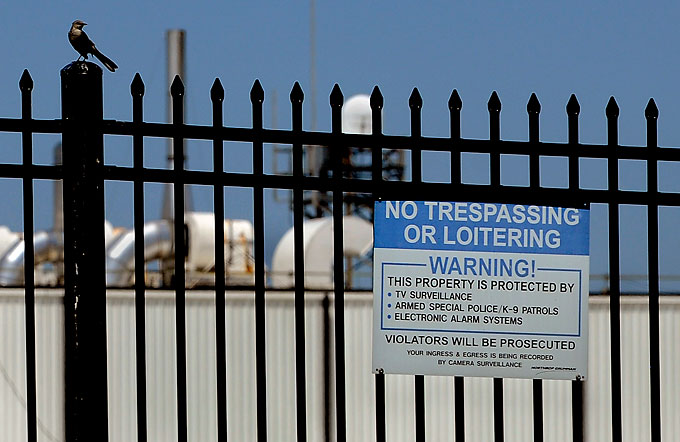
Trespassing is discouraged by high-security fencing and Jersey walls along the edge of Jerome James's property. (Photo by Michael S. Williamson / The Washington Post)
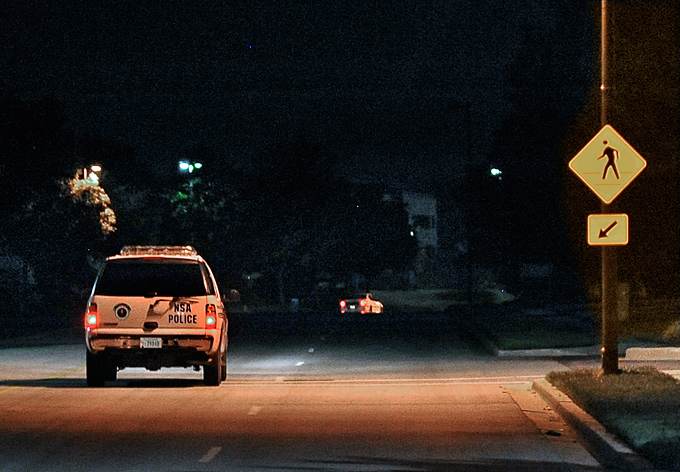
An NSA police vehicle patrols the roads around and near The National Business Park complex. (Photo by Michael S. Williamson / The Washington Post)
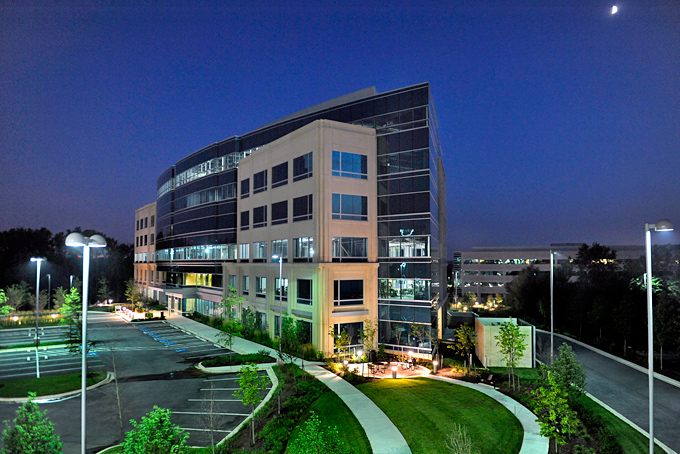
The National Business Park has scores of business that do intelligence work for the U.S. Government. (Photo by Michael S. Williamson / The Washington Post)
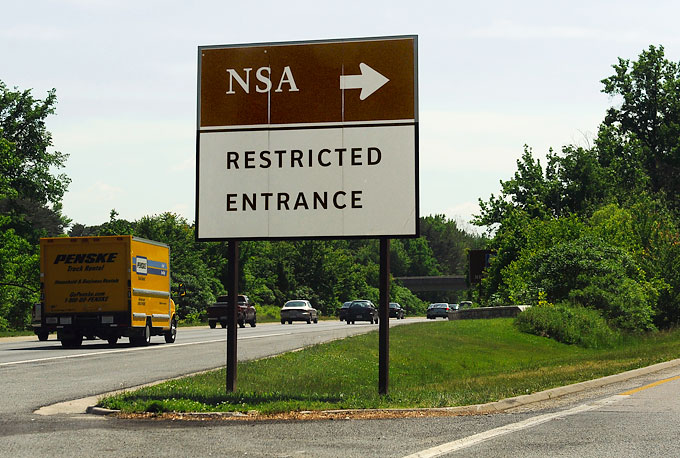
An exit marker points to the National Security Agency. (Photo by Michael S. Williamson / The Washington Post)
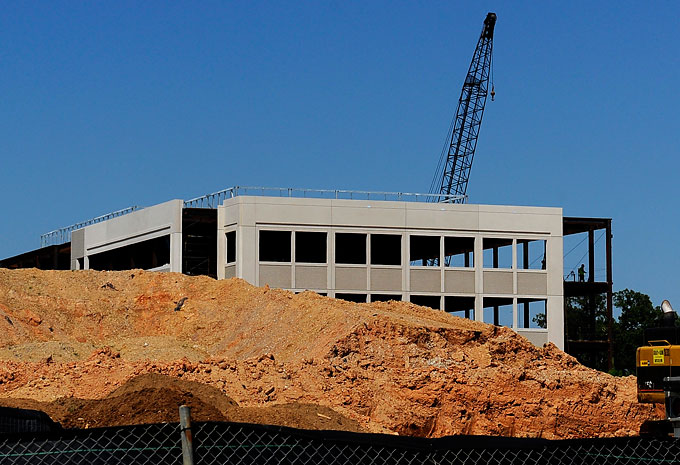
Near the NSA, ground is being broken for new buildings. (Photo by Michael S. Williamson / The Washington Post)
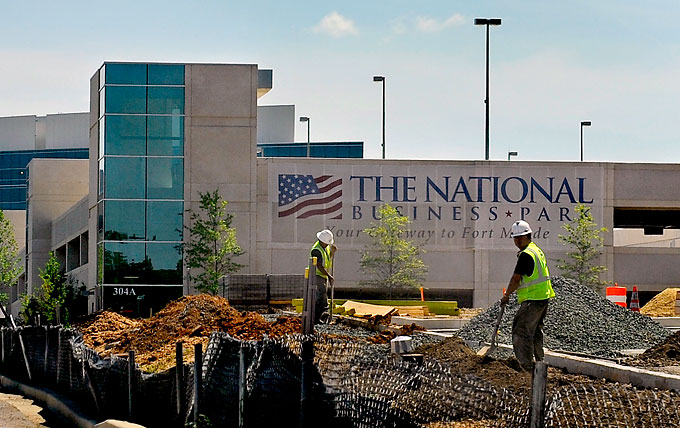
The National Business Park is near the National Security Agency and Fort Meade. (Photo by Michael S. Williamson / The Washington Post)
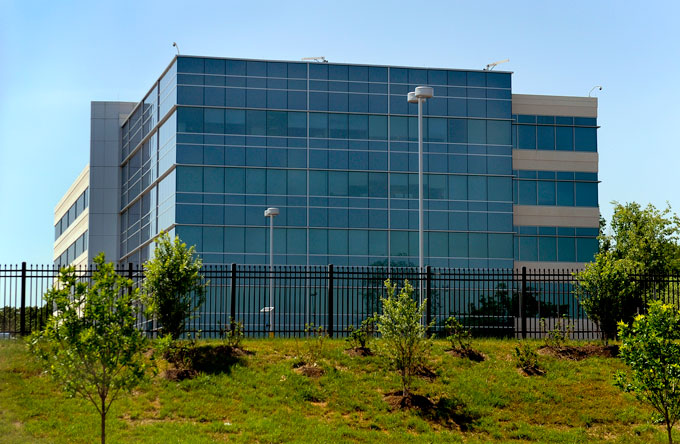
One of the many corporate buildings near the National Security Agency. (Photo by Michael S. Williamson / The Washington Post)

One of Northrup Grumman's 19 offices in the vicinity of the National Security Agency. (Photo by Michael S. Williamson / The Washington Post)
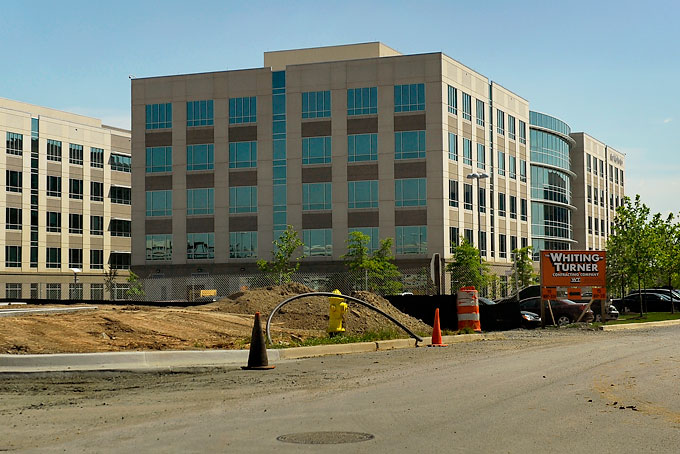
Projects at the National Business Park will expand the area available for top-secret work. (Photo by Michael S. Williamson / The Washington Post)
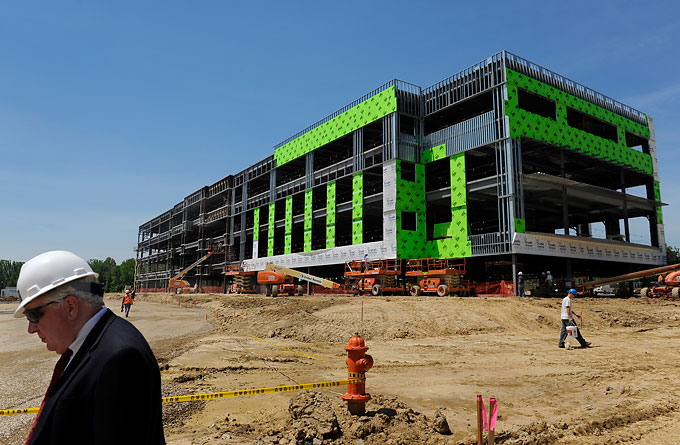
Dennis Lane of Ryan Commercial Real Estate Services is erecting a building with more than $1 million in security upgrades in hopes of landing government tenants. (Photo by Michael S. Williamson / The Washington Post)

A local cafe advertises a job fair for people with proper security credentials. (Photo by Michael S. Williamson / The Washington Post)

L-3 Communications is among the many companies performing secure work for the U.S. government. (Photo by Michael S. Williamson / The Washington Post)
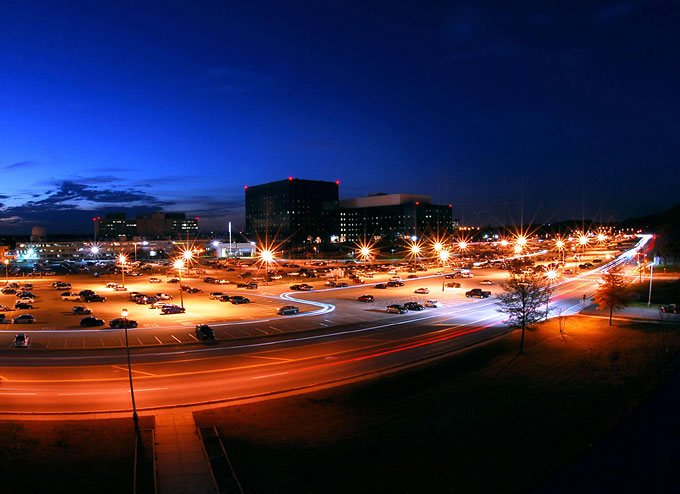
The N.S.A. properties in Maryland total 8.6 million square feet of office space, 1.3 times as big as the Pentagon. (Photo by Sandra McConnell, N.S.A.)
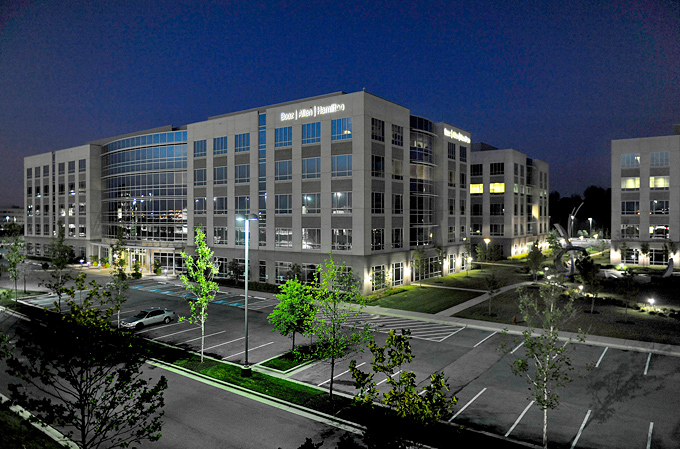
The National Business Park complex is located near Ft. Meade and only blocks from N.S.A. Headquarters. (Photo by Michael S. Williamson / The Washington Post)

Jeani Burns says being in a relationship with someone in the intelligence community comes with limits. She would prepare friends by cautioning them not to ask about his work. (Photo by Michael S. Williamson / The Washington Post)
It's not only the number of buildings that suggests the size and cost of this expansion, it's also what is inside: banks of television monitors. "Escort-required" badges. X-ray machines and lockers to store cellphones and pagers. Keypad door locks that open special rooms encased in metal or permanent dry wall, impenetrable to eavesdropping tools and protected by alarms and a security force capable of responding within 15 minutes. Every one of these buildings has at least one of these rooms, known as a SCIF, for sensitive compartmented information facility. Some are as small as a closet; others are four times the size of a football field.
SCIF size has become a measure of status in Top Secret America, or at least
in the
SCIFs are not the only must-have items people pay attention to. Command centers,
internal television networks, video walls, armored SUVs and
personal security guards have also become the bling of national security.
"You can't find a four-star general without a security detail," said one
three-star general now posted in
----
Among the most important people inside the SCIFs are the low-paid employees carrying their lunches to work to save money. They are the analysts, the 20- and 30-year-olds making $41,000 to $65,000 a year, whose job is at the core of everything Top Secret America tries to do.
At its best, analysis melds cultural understanding with snippets of
conversations, coded dialogue, anonymous tips, even scraps of trash, turning
them into clues that lead to individuals and groups trying to harm the
Their work is greatly enhanced by computers that sort through and categorize data. But in the end, analysis requires human judgment, and half the analysts are relatively inexperienced, having been hired in the past several years, said a senior ODNI official. Contract analysts are often straight out of college and trained at corporate headquarters.
When hired, a typical analyst knows very little about the priority countries
-
The problem with many intelligence reports, say officers who read them, is that they simply re-slice the same facts already in circulation. "It's the soccer ball syndrome. Something happens, and they want to rush to cover it," said Richard H. Immerman, who was the ODNI's assistant deputy director of national intelligence for analytic integrity and standards until early 2009. "I saw tremendous overlap."
Even the analysts at the National Counterterrorism Center (NCTC), which is supposed to be where the most sensitive, most difficult-to-obtain nuggets of information are fused together, get low marks from intelligence officials for not producing reports that are original, or at least better than the reports already written by the CIA, FBI, National Security Agency or Defense Intelligence Agency.
When Maj. Gen. John M. Custer was the director of intelligence at U.S. Central Command, he grew angry at how little helpful information came out of the NCTC. In 2007, he visited its director at the time, retired Vice Adm. John Scott Redd, to tell him so. "I told him that after 41/2 years, this organization had never produced one shred of information that helped me prosecute three wars!" he said loudly, leaning over the table during an interview.
Two years later, Custer, now head of the Army's intelligence school at
He's hardly the only one irritated. In a secure office in
It's too much, he complained. The inbox on his desk was full, too. He threw up his arms, picked up a thick, glossy intelligence report and waved it around, yelling.
"Jesus! Why does it take so long to produce?"
"Why does it have to be so bulky?"
"Why isn't it online?"
The overload of hourly, daily, weekly, monthly and annual reports is actually counterproductive, say people who receive them. Some policymakers and senior officials don't dare delve into the backup clogging their computers. They rely instead on personal briefers, and those briefers usually rely on their own agency's analysis, re-creating the very problem identified as a main cause of the failure to thwart the attacks: a lack of information-sharing.
The ODNI's analysis office knows this is a problem. Yet its solution was another publication, this one a daily online newspaper, Intelligence Today. Every day, a staff of 22 culls more than two dozen agencies' reports and 63 Web sites, selects the best information and packages it by originality, topic and region.
Analysis is not the only area where serious overlap appears to be gumming up the national security machinery and blurring the lines of responsibility.
Within the Defense Department alone, 18 commands and agencies conduct
information operations, which aspire to manage foreign audiences’ perceptions of
And all the major intelligence agencies and at least two major military commands claim a major role in cyber-warfare, the newest and least-defined frontier.
"Frankly, it hasn't been brought together in a unified approach," CIA Director Panetta said of the many agencies now involved in cyber-warfare.
"Cyber is tremendously difficult" to coordinate, said Benjamin A. Powell, who served as general counsel for three directors of national intelligence until he left the government last year. "Sometimes there was an unfortunate attitude of bring your knives, your guns, your fists and be fully prepared to defend your turf." Why? "Because it's funded, it's hot and it's sexy."
Last fall, U.S. Army Maj. Nidal Malik Hasan allegedly opened fire at
But none of this reached the one organization charged with handling
counterintelligence investigations within the Army. Just 25 miles up the road
from Walter Reed, the Army's 902nd Military Intelligence Group had been doing
little to search the ranks for potential threats. Instead, the 902's commander
had decided to turn the unit's attention to assessing general terrorist
affiliations in the
The 902nd, working on a program the commander named RITA, for Radical Islamic
Threat to the Army, had quietly been gathering information on Hezbollah, Iranian
Republican Guard and al-Qaeda student organizations in the
Secrecy and lack of coordination have allowed organizations, such as the 902nd in this case, to work on issues others were already tackling rather than take on the much more challenging job of trying to identify potential jihadist sympathizers within the Army itself.
Beyond redundancy, secrecy within the intelligence world hampers effectiveness in other ways, say defense and intelligence officers. For the Defense Department, the root of this problem goes back to an ultra-secret group of programs for which access is extremely limited and monitored by specially trained security officers.
These are called Special Access Programs - or SAPs - and the Pentagon's list of code names for them runs 300 pages. The intelligence community has hundreds more of its own, and those hundreds have thousands of sub-programs with their own limits on the number of people authorized to know anything about them. All this means that very few people have a complete sense of what's going on.
"There's only one entity in the entire universe that has visibility on all SAPs - that's God," said James R. Clapper, undersecretary of defense for intelligence and the Obama administration's nominee to be the next director of national intelligence.
Such secrecy can undermine the normal chain of command when senior officials use it to cut out rivals or when subordinates are ordered to keep secrets from their commanders.
One military officer involved in one such program said he was ordered to sign a document prohibiting him from disclosing it to his four-star commander, with whom he worked closely every day, because the commander was not authorized to know about it. Another senior defense official recalls the day he tried to find out about a program in his budget, only to be rebuffed by a peer. "What do you mean you can't tell me? I pay for the program," he recalled saying in a heated exchange.
Another senior intelligence official with wide access to many programs said that secrecy is sometimes used to protect ineffective projects. "I think the secretary of defense ought to direct a look at every single thing to see if it still has value," he said. "The DNI ought to do something similar."
The ODNI hasn't done that yet. The best it can do at the moment is maintain a database of the names of the most sensitive programs in the intelligence community. But the database does not include many important and relevant Pentagon projects.
Because so much is classified, illustrations of what goes on every day in Top Secret America can be hard to ferret out. But every so often, examples emerge. A recent one shows the post-9/11 system at its best and its worst.
Last fall, after eight years of growth and hirings, the enterprise was at
full throttle when word emerged that something was seriously amiss inside
In
That was the system as it was intended. But when the information reached the
As military operations in
Somewhere in that deluge was even more vital data. Partial names of someone
in
These were all clues to what would happen when a Nigerian named Umar Farouk
Abdulmutallab left
"There are so many people involved here," NCTC Director Leiter told Congress.
"Everyone had the dots to connect," DNI Blair explained to the lawmakers. "But I hadn't made it clear exactly who had primary responsibility."
And so Abdulmutallab was able to step aboard Northwest Airlines Flight 253.
As it descended toward
Blair acknowledged the problem. His solution: Create yet another team to run down every important lead. But he also told Congress he needed more money and more analysts to prevent another mistake.
More is often the solution proposed by the leaders of the 9/11 enterprise. After the Christmas Day bombing attempt, Leiter also pleaded for more - more analysts to join the 300 or so he already had.
The Department of Homeland Security asked for more air marshals, more body scanners and more analysts, too, even though it can't find nearly enough qualified people to fill its intelligence unit now. Obama has said he will not freeze spending on national security, making it likely that those requests will be funded.
More building, more expansion of offices continues across the country. A $1.7
billion NSA data-processing center will be under construction soon near
Just north of
Meanwhile, five miles southeast of the White House, the DHS has broken ground for its new headquarters, to be shared with the Coast Guard. DHS, in existence for only seven years, already has its own Special Access Programs, its own research arm, its own command center, its own fleet of armored cars and its own 230,000-person workforce, the third-largest after the departments of Defense and Veterans Affairs.
Soon, on the grounds of the former St. Elizabeths mental hospital in Anacostia, a $3.4 billion showcase of security will rise from the crumbling brick wards. The new headquarters will be the largest government complex built since the Pentagon, a major landmark in the alternative geography of Top Secret America and four times as big as Liberty Crossing.